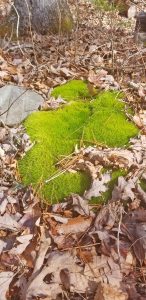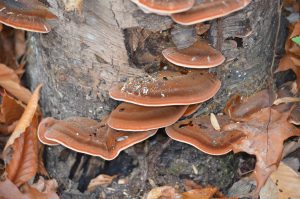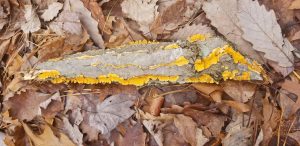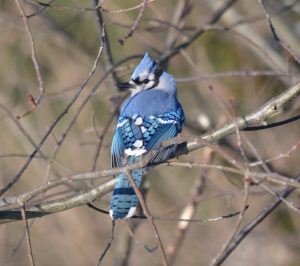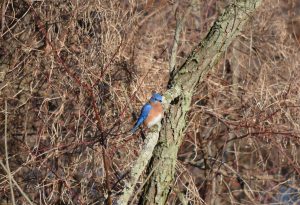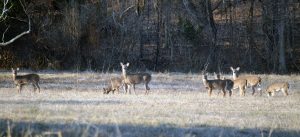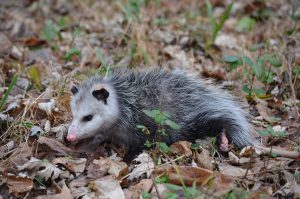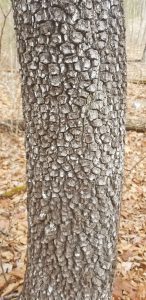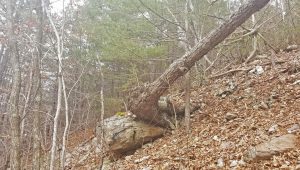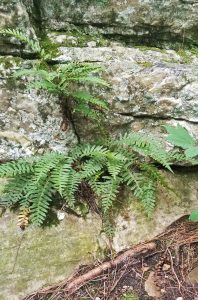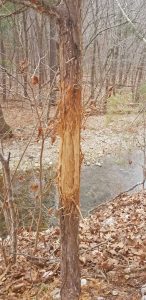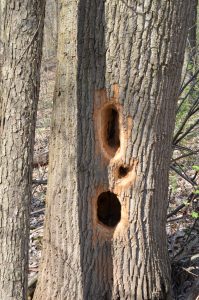I walked through the quiet forest with no real purpose. Just slowly poking my way through the many oaks, hickories and scattered pines. My binoculars hung around my neck and camera bag was strapped on my back. It was early January, but the landscape was without snow or ice, almost bare-looking, covered in shades of gray and dull brown. As a nature photographer and outdoor enthusiast, I sometimes feel “challenged” at this time of year to find interesting outdoor subjects to photograph and keep my attention, especially during periods without snow. Without any of the white stuff, it almost feels as if winter has become an “in-between season.”
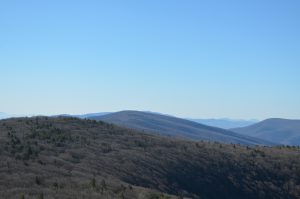 I’ve stopped short of saying “uninspired,” because every opportunity I get to venture outdoors in nature I cherish, and feel privileged to be able to experience. I get inspiration from even the smallest details in nature! As author Margaret Wolfe Hungerford wrote in her book ‘Molly Bawn’ (1878). … “It’s true that beauty is in the eye of the beholder.” So what do I look for in a bleak winter landscape? What features are worthy of further investigation, or a picture or two? For me, it may be COLORS that contrast to the grays and browns of the dormant forest, or MOVEMENTS of critters that may be trying to sneak past me, or fly by. My camera lens may also find UNIQUE PATTERNS or even SIGNS OF WILDLIFE that have come and gone. Or sometimes I just wander, not paying attention to anything in particular, and never snapping a single photo.
I’ve stopped short of saying “uninspired,” because every opportunity I get to venture outdoors in nature I cherish, and feel privileged to be able to experience. I get inspiration from even the smallest details in nature! As author Margaret Wolfe Hungerford wrote in her book ‘Molly Bawn’ (1878). … “It’s true that beauty is in the eye of the beholder.” So what do I look for in a bleak winter landscape? What features are worthy of further investigation, or a picture or two? For me, it may be COLORS that contrast to the grays and browns of the dormant forest, or MOVEMENTS of critters that may be trying to sneak past me, or fly by. My camera lens may also find UNIQUE PATTERNS or even SIGNS OF WILDLIFE that have come and gone. Or sometimes I just wander, not paying attention to anything in particular, and never snapping a single photo.
Here in the mountains of Virginia, unless Sasquatch struts in front of me, usually the first thing that grabs my attention on a woodland walk in January is a splash of COLOR. Any color that stands out among the endless, gray stands of leafless deciduous trees or brown blanket of dead leaves that make-up the forest floor. Hues of greens from evergreen trees, shrubs and vines, as well as mosses and lichens always invite me to explore them further.
If you look closely in the forest, bright greens of mosses and reds of Winterberry (above) can add a splash of color to a gray-looking landscape. The forest floor can also be worthy of exploring, as a variety of fungi and lichens (below) are surprisingly easy to find, and make great photos.
 In addition, as a birder I feel confident I can usually find birds somewhere during my outings. But bright year-round plumages of some of our common birds, such as Northern Cardinals, Blue Jays, Eastern Bluebirds or even the large elegant-looking Pileated Woodpecker, makes them easier to spot in the somewhat dreary woodlands. But their color isn’t the only thing I notice, it’s their movement in a still environment.
In addition, as a birder I feel confident I can usually find birds somewhere during my outings. But bright year-round plumages of some of our common birds, such as Northern Cardinals, Blue Jays, Eastern Bluebirds or even the large elegant-looking Pileated Woodpecker, makes them easier to spot in the somewhat dreary woodlands. But their color isn’t the only thing I notice, it’s their movement in a still environment.
If you spend enough time in the outdoors your senses become a bit more acute, and you become much more aware of your surroundings. As you pause for a few minutes, small MOVEMENTS may catch your eye. It might simply be the erratic flight of a Downy Woodpecker flying from tree to tree in search of insects, or a small group of winter gray White-tailed Deer sneaking through a patch of thick brush. If I’m lucky, I might catch a glimpse of a curious Opossum busily foraging in the dead leaves. In the forest, horizontal movements against a landscape dominated by vertical (trees/shrubs) features is what draws my attention. These could only be for a few brief seconds, but may provide a memory that lasts for much longer!
When wildlife is absent during my woodland walk, my focus may simply turn to what I can find and discover along my route. These could be UNIQUE PATTERNS, such as the different bark of trees, different types of rocks, or just interesting looking tree growth. And if I don’t spot any critters, I always love searching for SIGNS OF WILDLIFE. What animals were in the area? What were they doing and which direction were they traveling? Did they leave anything behind as evidence? These clues may be lead to further investigation. The forest has many mysteries to solve, many stories to tell! Some of these hidden treasures might be a buck rub on a small sapling, mysterious tracks left in the mud along a small stream, a feather laying on a fallen log, or the mighty holes created by woodpeckers searching for bugs. Signs of wildlife, big and small, are all around us. We just have to slow down and take it all in!
Tree bark can show distinct and unusual patterns, and are much more noticeable in the winter (above). In the winter, I also enjoy photographing plants that grow in unusual places (below).
Wildlife signs may include buck rubs and woodpecker holes.
From a distance, the gray forest in January may look lifeless, dreary, or even boring. But if you take your time, open up your senses (and imagination) and become a nature detective, you just might discover some of the hidden beauties that brighten up your gray day! Enjoy the outdoors!
